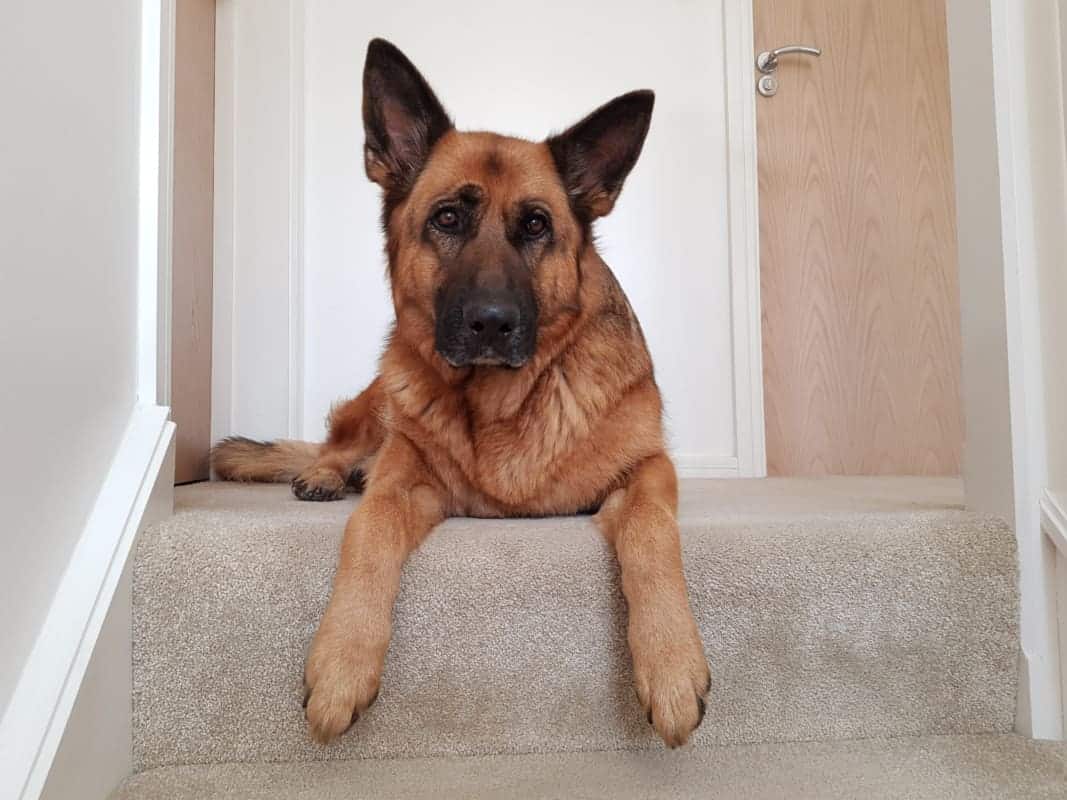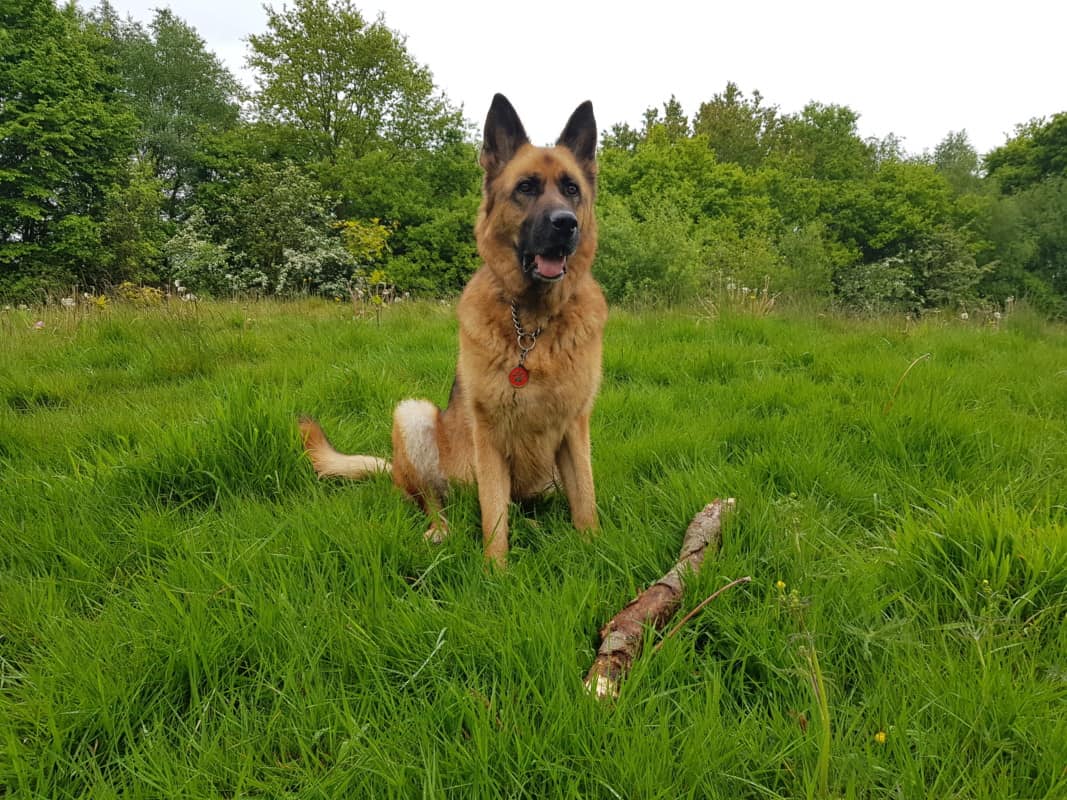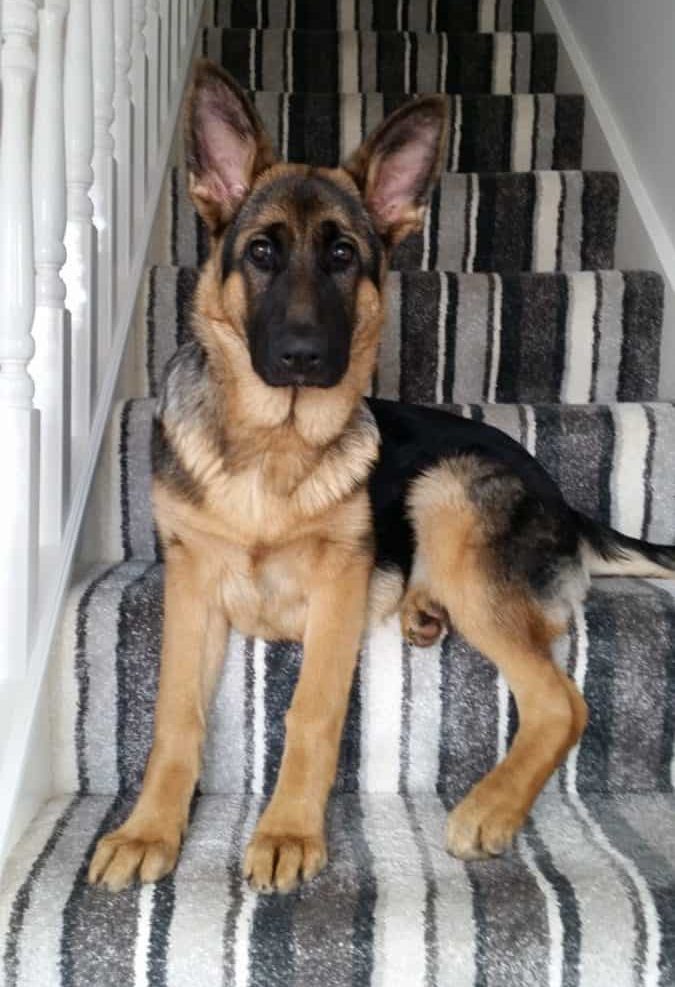German Shepherds are known as athletic, loyal, and extremely intelligent dogs. While they love to exercise and be active, there is still a question surrounding how good the stairs are for these wonderful dogs. Are stairs bad for German Shepherds?
Stairs are not bad for healthy German Shepherds. However, limiting their use of stairs is ideal since the breed is prone to hip and elbow dysplasia. If your dog suffers from either of those conditions, then reduce its use of stairs. Puppies should not use stairs until they are at least 3 months old.
As with any animal, you want to make sure they are comfortable doing any task and are safe and healthy in the process. There are some easy best practices to follow to ensure your German Shepherd can tackle stairs with no issues and when you may need to help them.
To learn more about whether stairs are bad for German Shepherds, read on!

Healthy German Shepherds and Stairs
If your German Shepherd is young and healthy, you shouldn’t have anything to worry about. But taking some extra precautions never hurts, either.
Adult German Shepherds range from 50 up to 90 pounds, on average. There can be many variations to this, either way. As an example, my female German Shepherd is very tall, long, and weighs 88lbs!

You would think larger dogs will have an easier time with stairs, but that’s not always the case. Their long legs and strong muscles will make it easier to ascend or descend, but they are also carrying a large body with them. Their size can sometimes make stairs a bit of an awkward task.
Always make sure that any stairs they use are clear of obstacles such as a leftover bone! Sharp turns or unexpected challenges can be dangerous for any dog on stairs, but especially larger breeds. Large dogs can easily strain or sprain something if they are climbing up or downstairs and need to make a sudden adjustment due to an obstacle.
When German Shepherds are puppies, introduce them to stairs slowly, and not before they are at least three months old.
You always want to ensure they are comfortable and able to manage the stairs before allowing them to try on their own. Using praise and positive affirmations as they begin to master the mountain of stairs ahead of them. Luckily, German Shepherds are exceptionally intelligent and typically learn new tasks quickly.
If you only have a few stairs in your home and they do not need to climb them every day in their normal life, it is smart to wait even longer than three months if you can. If there is no pressing need for them to learn how to use stairs, put it off for a bit and allow their muscles and bones to develop more before allowing the extra stress on their joints.
Signs of Stair-related Injuries in German Shepherds
Due to the physical structure of German Shepherds, they’re easily prone to falls and injuries on stairs. If you haven’t been monitoring the activity of your GSD, it’s essential to look at a few signs that confirm if your dog has been susceptible to stair-related injuries or not.
Limping
The most common sign that confirms a stair-related or environment-related injury is limping. Your GSD can start to favor one leg over the other. As you gently touch the leg, you can spot the exact area of injury when your dog pulls back the leg or makes a screeching noise.
Decreased Mobility
After experiencing a stair-based injury, another common sign is to witness refusal and lethargy in your German Shepherd to move around or climb up the staircase. As time progresses, you can see a decreased mobility in your dog that’s adding up to his/her fear and stopping him/her from any physical activity.
Caution: When you notice decreased mobility in your dog, it’s essential to take it to a vet and also carry on with early medical intervention. A prolonged decrease in mobility can result in muscle stiffness and serious injuries that can be detrimental to their physical and mental health.
Vocalizing Frequently
As you take your dog for a walk, you may experience frequent vocalization and delay in walking. If you observe your dog’s leg movement closer, you can notice an inflammation. It’s a pain that’s developing vocalization frequently. This is another sign to confirm a stair-related injury.
Hip or Elbow Dysplasia and Stair Use
Any breed of dog prone to hip or elbow dysplasia will need to be more careful when it comes to stair use. So, what is hip dysplasia?
“Hip dysplasia is a genetic disease that is affected by factors such as diet, environment, exercise, growth rate, muscle mass, and hormones.”
VCA Hospitals
German Shepherd puppies are born with perfectly normal and healthy hips. However, birth to 8 weeks old is a crucial time for proper growth and development of hips in dogs, so the type of exercise GSD pups have is very important during this time.
According to The Institute of Canine Biology, puppies that regularly use stairs when they are younger than three months old pose a higher risk for hip dysplasia later in life. This is important since German Shepherds are already a breed that is a high risk for the condition.
This is why it is so important to wait long enough before training them on the stairs. It can even be beneficial to allow more time than three months, if possible. Giving them time to develop further before having them tackle the stairs will not only help keep them safe, but will also give you an extra excuse to scoop your cute pup up in your arms and carry him more often!
If your German Shepherd has been diagnosed with hip or elbow dysplasia, your veterinarian will be able to tell you specifics regarding how much activity is too much and the types of activity he can handle.
It’s also a good idea to get an orthopedic dog bed such as the Big Barker, which has been recently clinically proven in this study to improve joint function and reduce pain. It can also help prevent future joint problems that German Shepherds and all large breed dogs are at risk of developing. I love this one as it comes with a 10-year guarantee, and it’s the bed that I use.
Using stairs can be painful for a dog with hip or elbow dysplasia. Often, you may be able to see the early signs of either condition because of a new apprehension surrounding climbing stairs. If they seem to manage other tasks but suddenly hesitate or refuse to climb the stairs, treat that as a red flag and call your vet.
Some other warning signs include:
- Unable to stand on hind legs
- Extreme stiffness that lasts a long time after getting up
- Limping
- Lethargy caused by pain from moving, not caused by an accident
Don’t worry, though, as not all German Shepherds have bad hips. You can also help to reduce the risk by choosing a reputable breeder in the first instance and ensuring both parents have a low hip score. A reliable and honest breeder will only breed from dogs that score below the breed average.
Helping Your German Shepherd with Dysplasia Use the Stairs
German Shepherds who are diagnosed with dysplasia will need help getting up and down any stairs. So, when that isn’t possible, you can still find ways to help them or limit their usage.
- Removing Stairs Altogether
If you can completely remove stairs from their life, that will be best. Buying a simple pet stair gate, such as the Carlson Pet Gate from Amazon, will be a quick and easy solution to make sure they aren’t sneaking trips up and down the stairs while you are not around. I like this one as it’s extra tall, so there’s definitely no jumping over!
Of course, carrying your dog may be necessary if you have lots of stairs in your home. But this may be easier said than done if your little fur baby weighs 88 pounds! This is where some other options may be handy.
- Ramps
If your German Shepherd only has a few stairs they need to climb for getting in and out of the house, or into a sunken living room, for example, then a ramp may be the best solution. Most ramps can also double as a way for them to get in and out of the car or other high places easier. Check out the Pet Gear Full Length Ramp on Amazon. It’s slip-resistant, lightweight, and portable and gets thousands of great reviews.
- Dog Lifter
If your German Shepherd does not have a severe case, but you still want to give them some help getting up and down stairs, a dog lifter could be a good solution. They offer a comfortable harness that allows you to help your dog take some of the weight off their legs as they tackle stairs or get in or out of the car.
Many companies sell these, which are perfect for German Shepherds. I like the look of this dog lift support harness, which looks really comfy for your dog’s underbelly, and it gets awesome reviews.
Why Stairs Can Be Good for Your German Shepherd
If your dog is healthy and active with no illness, injury, or condition, then stairs can be a great exercise. Stairs activate many different muscle groups and pose an excellent outlet for your dog’s energy when they might not be able to get out for a long play session that day.

Letting them run up and down occasionally will help tire them out and get them an excellent quick exercise on a rainy day when you might not be going for your usual long walk with them. No matter what the weather, though, German Shepherds still need to go for their walks, even if you do make them a little shorter.
Keeping your German Shepherd active and in a healthy weight range will also help fight the possibility of hip and elbow dysplasia, arthritis, or other mobility issues further down the line.
So, ensuring they get enough daily exercise and stick to a healthy diet will help decrease their risk.
Whilst we are on the subject of nutrition, it’s also very important if you are feeding your GSD dry kibble, to choose a brand specifically designed for large breed dogs. Here’s why!
Keeping Your German Shepherd Healthy and Safe on Stairs
Your healthy German Shepherd will be safe and able to use stairs without issue. Just make sure their path is clear, and they don’t need to over-utilize them daily, which can wear down their joints and cause them to be at a higher risk for hip or elbow dysplasia.
If they already have either condition, speak with your vet, and make necessary changes around the home to accommodate them.
Final Thoughts
Here are some key takeaways from the article:
- Stairs are not bad for German Shepherds as long as they are healthy.
- Puppies should avoid using stairs until they are at least 3 months old.
- If your German Shepherd suffers from hip dysplasia, it’s best to limit their use of stairs
- There are various items available to help you with this, such as stair gates, ramps, or dog lifters.
- Stairs can be an ideal form of indoor exercise for healthy German Shepherds.
Related Posts You May Like:





